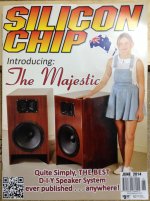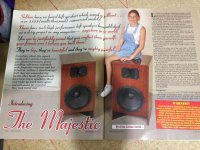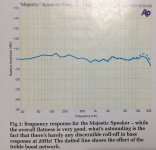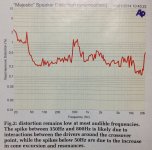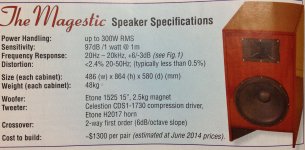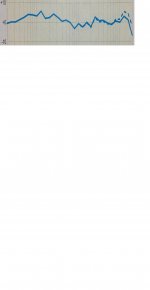June 2014 Silicon Chip magazine has just published details of a new system with mighty big claims and numbers. I have deliberately left off the construction details so you will have to go buy the mag to see what it is all about. if it is as good as they say then it's a mighty piece of work.
Attachments
If it wasn't for the QR code on the front, I'd be thinking that was an issue from about 1974...

+1. Looks like an old Radio Shack or Lafayette catalogue page.
June 2014 Silicon Chip magazine has just published details of a new system with mighty big claims and numbers. I have deliberately left off the construction details so you will have to go buy the mag to see what it is all about. if it is as good as they say then it's a mighty piece of work.
I can see:
- an undersized, old-school hard diffraction constant directivity horn
- claims of a "6dB/octave" crossover, which simply CANNOT be made to work with horns
A far cry from "the best", in my book.
Marco
Wow, that's "a little" hyperbole! Just writing something that is claiming to be "the best ever, anywhere" is pretty much showing you don't know jack right from the get go. I get the idea that someone with very little DIY experience wrote the piece and/or designed the speaker. For example, look at how the distortion plot was interpreted:
Was this "retro" month for the cover graphics??? From the 1960s? That is about where the article is coming from, too. Is it April 1st there, and the designer from Lirpa Labs?
Right. The crossover to that little horn is happening between 350Hz and 500Hz! Hahaha. The recommended frequency response range of the Celestion compression driver used in the project starts at 1200Hz. If it IS crossed over in that band, its a major mistake. And a 6dB/oct crossover? Eek. What are your fellow countrymen smoking down there, Circlotron?The spike between 350Hz and 800Hz is likely due to interactions between the drivers around the crossover point.
Was this "retro" month for the cover graphics??? From the 1960s? That is about where the article is coming from, too. Is it April 1st there, and the designer from Lirpa Labs?
Last edited:
Not to mention the cost of build.....$1300!
Where does that total come from?
The woofers are $110 each from Etone's website the tweeters are $130 each + horns.
With a 1st order crossover that means there are only 2 components per speaker, unless there is an extreme amount of parts for response shaping.
Not to mention the 97db efficiency CLAIM, the woofer is 97.2db efficient I don't understand how that is possible.
Where does that total come from?
The woofers are $110 each from Etone's website the tweeters are $130 each + horns.
With a 1st order crossover that means there are only 2 components per speaker, unless there is an extreme amount of parts for response shaping.
Not to mention the 97db efficiency CLAIM, the woofer is 97.2db efficient I don't understand how that is possible.
Given the low price of the drivers, it would be interesting for us Antipodeans to come up with a workable version if possible....
http://www.etonesound.com/FW SPEAKER DRIVERS.htm
My Unibox sims for that driver in a 220L box (from dimensions in article) give an F3 of 38Hz for a tuning of 34Hz as about the best you can hope for...???
http://www.etonesound.com/FW SPEAKER DRIVERS.htm
My Unibox sims for that driver in a 220L box (from dimensions in article) give an F3 of 38Hz for a tuning of 34Hz as about the best you can hope for...???
Last edited:
The published design does not use a plain port. Inside it has a long narrow slot that feeds a cavity of 10-15 litres that then feeds a port. Then as the port exits the underside of the box it feeds an exponential horn of sorts. Not sure how all this affects box tuning but there is an impedance minimum at ~20Hz.My Unibox sims for that driver in a 220L box (from dimensions in article) give an F3 of 38Hz for a tuning of 34Hz as about the best you can hope for...???
some sort of 'acoustic meat grinder' then.. I've always felt that these woofers would eb good in a sealed box with Linkwitz Transform, never tried it though, & Etone hasn't got any freq response graphs on their site, so how high they're usable to is open to question
(although the xover freq in the 'best speaker ever published' might be a clue)
(although the xover freq in the 'best speaker ever published' might be a clue)
Given the low price of the drivers, it would be interesting for us Antipodeans to come up with a workable version if possible....
etone PROFESSIONAL SOUND
My Unibox sims for that driver in a 220L box (from dimensions in article) give an F3 of 38Hz for a tuning of 34Hz as about the best you can hope for...???
I suspect that the response is drooping down starting around 40Hz. I'm guessing that it is a large box with lowered tuning. In the "right" room, e.g. one that provides matching room gain, the room response can combine with the rolled-off free-field response (up to the point where it becomes about 12dB per oct) to give a more or less flat response. So I suspect that this has been done, and the box tuning frequency is around 20Hz. The steeper rolloff of the vented box below tuning will kick in.
The frequency response plot is probably "in-room", otherwise no way its possible with this driver. Note the y-scale of 10dB per division. Hard to tell how flat the response is, but it's definitely not very flat. And who knows what kind of averaging was applied. You get the idea. There are lies, damn lies, and then this.
June 2014 Silicon Chip magazine has just published details of a new system
They don't specify (in what you have provided) how the FR was taken, or what SPL the distortion plot was taken at. The SPL plot looks like a room-averaged response. If one plotted some of the speakers many others here have designed on a pseudoanechoic +/- 50dB plot they would look a lot more like straight lines...
this article was meant to be publisehd in the April issue...
That was one of the things that passed thru my head too...
dave
- Status
- This old topic is closed. If you want to reopen this topic, contact a moderator using the "Report Post" button.
- Home
- Loudspeakers
- Multi-Way
- Silicon Chip mag "BEST diy speaker ever published anywhere"...
